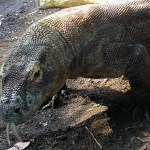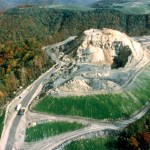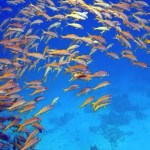conservation
This article is reposted from the old Wordpress incarnation of Not Exactly Rocket Science.
Twenty-two thousand sounds like a huge number. It's happens to be number of eastern Pacific gray whales currently swimming off the coast of North America. It's certainly much larger than 140, the number of whales that aboriginal people of this area are allowed to hunt. And it's far, far bigger than zero, the population size that the whales were rapidly approaching in the mid 20th century.
Obviously, it's all relative. Twenty-two thousand is still much less than ninety-six thousand. That's the size of…
And now, for another installment in our series: How The Loon Terns, an exercise in skeptical thinking using Loons as a waterbird touchstone. (In case you missed it, the previous installment was here.)
Common Knowledge: Loons are driven off lakes by boaters. The literature from the 1970s and 1980s makes it clear that there was a reduction in loon populations on lakes that were previously more isolated, and have become more accessible, and suffered greater amounts of boat traffic. Boats cause several problems for loons, including a damaging wake, and presumably it is bad if a loon is run…
tags: biodiversity, conservation, endangered species, Encyclopedia of Life, TEDTalks, E.O. Wilson, streaming video
As E.O. Wilson accepts his 2007 TEDTalks Prize, he makes a plea on behalf of all creatures that we learn more about our biosphere -- and build a networked encyclopedia of all the world's knowledge about life [24:22]
TEDTalks is a daily video podcast of the best talks and performances from the TED Conference, where the world's leading thinkers and doers are invited to give the talk of their lives in 18 minutes.
tags: Birds in the News, BirdNews, ornithology, birds, avian, newsletter
A once-in-a-lifetime photograph of a Common (Eurasian) Kingfisher, Alcedo atthis.
Image: orphaned [larger view].
Birds in Science
For centuries, scientists have puzzled over why the toucan's bill is so remarkably large -- but now one team thinks it might have an answer. The researchers say that the toucan uses its enormous beak to stay cool. They used infrared cameras to show the bird dumping heat from its body into its bill, helping it to regulate its body temperature. The toucan has the largest bill of any bird,…
Cities are noisy places. If you ever get annoyed by the constant din of traffic, machinery and increasingly belligerent inhabitants, think about what songbirds must think. Many birds rely on songs to demarcate their territories and make their advances known to mates. They listen out not just for the sounds of seduction or rivalry, but for approaching predators and alarm calls that signify danger. Hearing these vital notes may be the different between life and death.
Last year, I wrote a feature for New Scientist about the effect that urban noise has on songbirds. Those that can't make…
tags: Sylvia Earle, oceans, TEDTalks, conservation, streaming video
Legendary ocean researcher Sylvia Earle shares astonishing images of the ocean -- and shocking stats about its rapid decline -- as she makes her TED Prize wish: that we will join her in protecting the vital blue heart of the planet. [18:16]
TEDTalks is a daily video podcast of the best talks and performances from the TED Conference, where the world's leading thinkers and doers give the talk of their lives in 18 minutes.
Yesterday I did a day of work in London. Because everything finished far earlier than I was anticipating, I had time to kill so, accompanied by trusty sidekick John Conway, what else could I do but spend a few hours at ZSL's London Zoo (ZSL = Zoological Society of London)? We had a great time and saw some neat creatures: here are a few of the highlights. We start with one of the most awesome creatures on the planet...
Yes, the incredible Komodo dragon Varanus komodoensis. To be honest I'd forgotten that they have them there: I think there are also dragons at Chester Zoo, Colchester Zoo and (…
tags: Birds in the News, BirdNews, ornithology, birds, avian, newsletter
Birdwatchers in southeastern Australia have been thrilled to see the arrival of about a third of the total national population of the highly endangered Swift Parrot, Lathamus discolor, on the Far South Coast.
Image: Max Sutcliffe, Narooma News [larger view].
Birds in Science
Bird deaths around the Baltic Sea and possibly elsewhere in the world may be caused by a shortage of the vitamin thiamine, researchers say. Wild birds of varied species along the Baltic coasts have been dying of hard-to-explain paralysis since…
We think of spiders as fearsome hunters, spinners of webs and treacherous mates, but construction workers? Yes, that too. Some groups of spiders - trapdoor and wolf spiders - dig tunnels that they use to ambush passing insects. But these tunnels can also provide shelter and accommodation for other animals, including one of the rarest of Australia's lizards - the pygmy blue-tongue lizard. It seems that the lizard's survival depends entirely on the spiders.
The pygmy blue-tongue is a native of South Australia. It's so rare that zoologists thought it extinct for over 30 years and it re-emerged…
tags: Birds in the News, BirdNews, ornithology, birds, avian, newsletter
Plump and hoping to get plumper, a red knot takes a break from eating horseshoe crab eggs at Mispillion Harbor.
Image: Louisa Jonas/WYPR [larger view].
Birds in Science
Catching adult eagles for research purposes is no easy task, but a Purdue University researcher has found a way around the problem, and, in the process, gathered even more information about the birds without ever laying a hand on one. "Many birds are small, easy to catch and abundant," said Andrew DeWoody, associate professor of forestry and natural…
The naming of new amphibian species is a fairly routine thing. This doesn't mean that - despite the global amphibian crisis - amphibians are actually ok and that we can stop worrying; it means that we haven't been paying enough attention, and indeed many of the species that are being named anew are endangered, or threatened, or with tiny ranges.
The current edition of Journal of Zoology includes the description of a new plethodontid salamander (aka lungless salamander): the Patch-nosed salamander Urspelerpes brucei Camp et al., 2009. The big deal about this entirely new species is that it's…
tags: Ivory-Billed Woodpecker, Campephilus principalis, grail bird, bird watching, conservation, documentary, streaming video
No, I do not believe that the Ivory-billed Woodpecker lives, but this trailer makes the documentary film look interesting anyway, mostly because it focuses on the people; the residents of the town nearest the "rediscovery site", the scientists, the politics and the media frenzy surrounding this "Grail Bird" [3:29]
Here's a somewhat rambling interview with the film's director, Scott Crocker, who is articulate (and very fun to look at) [9:37];
I would like to point…
"It seems really very unfair that man should have chosen the gorilla to symbolize everything that is aggressive and violent, when that is one thing that gorillas are not, and that we are."- Sir Richard Attenborough
This quote sets the tone for a new award winning short film (see below) from the non-profit organization Explore. Primates, and great apes in particular, have long fascinated and repulsed us based on their uncanny resemblance. In order to deflect this repulsion they have frequently been portrayed as monstrous, violent and expressing a host of bestial attributes. A case in point…
Last Tuesday, West Virginia State Police arrested NASA climate scientist James Hansen for trespassing on a Massey Energy-owned coal plant near the state's Coal River Valley. Thirty-one demonstrators--also including actress Daryl Hannah and former West Virginia Representative Ken Hechler--were apprehended while protesting the company's practice of mountaintop removal mining, which both perpetuates the use of coal as a source of fuel and devastates surrounding natural habitats. Hansen has long advocated against mountaintop removal, and criticized the Obama administration's recent pledge to…
tags: Birds in the News, BirdNews, ornithology, birds, avian, newsletter
The first Seychelles Paradise-flycatcher chicks, Terpsiphone corvina,
to fledge successfully outside La Digue Island, Seychelles for over 60 years
are flying on Denis Island.
Image: David Hosking [larger view].
Birds in Science
One of the fifteen Frisian 'transmitter godwits', which was still in Friesland on one week ago on Saturday, arrived in Senegal in West Africa on Tuesday morning. The bird, nicknamed Heidenskip, appears to have flown from Friesland via Spain and over the Sahara in one go. The distance, over…
tags: Birds in the News, BirdNews, ornithology, birds, avian, newsletter
Gyrfalcon chicks in 2500 year-old nest in Greenland. Gyrfalcons are the largest species of falcon in the world.
Image: Jack Stephens.
This edition of Birds in the News is dedicated to Bob, Asa, Neil and Biosparite in honor of their kind $upport. I deeply appreciate your generosity and thoughtfulness.
Birds and Science
Why aren't birds larger? Fifteen-kilogram swans hold the current upper size record for flying birds, although the extinct Argentavis of the Miocene Epoch in Argentina is estimated to have weighed 70…
As scientists often lament, science in the entertainment industry is often ignored or misportrayed outside the realm of science fiction. But two compelling new documentaries have ScienceBloggers hopeful that their messages will have the mass-market appeal of films such as An Inconvenient Truth or Fast Food Nation. The End of the Line, which Darren Naish calls "captivating, charismatic and beautifully filmed," investigates the alarming effects of overfishing and the exploitation of marine resources. Food Inc., co-produced by Fast Food Nation director Eric Schlosser, aims to expose the extent…
Endangered Parrots of the World Chess Set [larger view].
Do you know someone who loves chess, art and parrots? If so, you might wish to start saving your money now for a Christmas gift that they would probably love: an Endangered Parrots of the World Chess Set.
This environmentally-friendly hand-made Chess Set was created by Grant Dawson Collections in the United States from certified sustainable North American hardwoods (walnut and maple) and food safe natural finishes, with recycled glass ball feet, and features 32 lead-free pewter playing pieces finished in 24k gold or sterling silver…
In 1979, somewhere in Dartmoor, a butterfly died. That would hardly have been an exceptional event, but this individual was a Large Blue butterfly (Maculinea arion) and it was the last of its kind in the United Kingdom. Over more than a century, the Large Blue's population had been declining and it was finally declared nationally extinct 30 years ago.
Now, it's back. A bold conservation effort managed to work out the factors behind the butterfly's decline, and resurrect this vanished species. The Large Blue's reintroduction has been one of conservation's flagship successes and it was the…
The observation of World Oceans Day June 8 sparked a lively online debate about the environmental repercussions of seafood consumption. Is it possible to know whether the fish you are eating is truly sustainable? Why is Pacific cod "safe" but Atlantic cod off limits? Is farm-raised salmon really better than wild? Jennifer Jacquet of Guilty Planet, who works with the Sea Around Us Project at the University of British Columbia Fisheries Center, argues that the best solution is to refrain from eating seafood altogether. "I believe people are realizing that the 'choose this but not that'…




